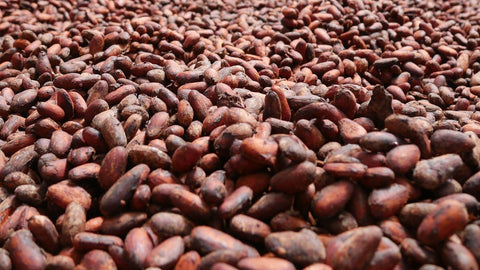Healthy Dark Chocolate: Five Common Myths
Lately, a number of friends have mentioned they’re switching to dark chocolate for their health or to reduce sugar in their diet. Yet – when they mention their brands of choice, alarm bells and sirens go off in my head. I’ve learned a lot about ingredients and labeling in recent years. I’m now shocked by the processing techniques and “stuff” that sneaks into chocolates I once thought of as healthier or higher quality. Here, I highlight the main myths and mistakes I’ve seen so you can shop like a pro.
I have summarized each myth in this table. If you’re interested in learning more, click on the myth to jump to even greater detail.

Myth 1: All Dark Chocolate is made primarily from Cocoa Beans
Fact: Even “dark chocolates” can still be primarily sugar; Hershey’s Special Dark and Dove Dark Chocolate are popular examples. Unless the % Cacao Content is called out on the label, chances are that even dark chocolate is primarily sugar. Check the ingredients list and avoid chocolates that list sugar as the first ingredient (or the first ingredient in parenthesis after chocolate). Need recommendations? Snacking Cacao is, of course, high in cacao content! For chocolates: ALL of the dark chocolate carried at nearby Chocolopolis is above 50% cacao content. And, if you’re searching at the grocery store, try fairly traded and organic* brands such as Seattle neighbor Theo*, Divine, Equal Exchange* or Beyond Good*.
Meanwhile, the product name (aka FDA Standard of Identity) on the label can give you a few hints. Here’s what they mean:
- Dark Chocolate: [typically] a minimum of 35% cacao + cacao butter content and NO dairy/milk. Since the Dark Chocolate term is NOT regulated, it can contain less than 35% cacao content and up to 12% milk products before it must be called Milk Chocolate. Semisweet or Bittersweet ARE regulated terms and MUST have at least 35% cocoa content.[i],[ii]
- Dark Milk Chocolate: typically at least 35% cacao + cacao butter content AND more than 12% milk/dairy solids (with at least 3.39% milkfat).
- Milk Chocolate: has more milk than chocolate! Minimum of 10% cacao content (by law) AND more than 12% milk/dairy solids (with at least 3.39% milkfat).
Generally understood subsets of “dark” chocolate:
- Semisweet – a minimum of 35% cacao + cacao butter content. Typically in the 35-50% range.
- Bittersweet – typically more than 50% cacao content.[iii]
- Extra Dark – typically at least 60%+ cacao content range
Other Categories:
- Mylk Chocolate: like Milk Chocolate definitions above, however, the alternate spelling of “Milk” typically signals non-dairy / plant-based “mylk” like coconut or oat.
- Chocolatey / Chocolate-flavor: doesn’t qualify as chocolate because either 1) it has less than 10% cacao content or 2) it’s a bar or chip that doesn’t contain cocoa butter. For the latter, cacao powder is combined with an alternative [cheaper] fat/vegetable oil instead of cacao butter.[iv] Butterfinger is a well-known candy that doesn’t qualify as chocolate.

Myth 2: All Dark Chocolate is Vegan
Fact: Even if you avoid Dark Milk Chocolates, there are a few watch-outs for Vegan Diets. Honey is more obvious to avoid since it’s made by bees. But, cane sugar can be refined using bone char. Bone char isn’t actually in the sugar, but rather a processing aid that doesn’t align with a Vegan lifestyle. To ensure your chocolate is Vegan-friendly, look for the descriptor organic, natural, raw, or unrefined with regard to cane sugar.[v],[vi]
Watch out: I’ve noticed a recent trend of very high % cacao content dark chocolate bars adding milk fat (legally, they can add up to 12% dairy product before calling it “Milk”). Ghirardelli Chocolate Intense Dark Chocolate Moonlight Mystique 92% Cacao is a great example of this. Not only is it not Vegan, but Milk Fat can still be allergenic for those sensitive to Dairy / Milk. Be careful!
All of Good King’s Snacking Cacao is Vegan. If you want a Vegan Milk Chocolate, I’m a huge fan of fellow Seattle maker ChocolateSpiel also makes an incredible Latte Bar (with coconut milk) with our Honduras Beans available on our website. Yum! Finally, many of the same brands I mentioned for dark chocolate are also vegan - Theo, Equal Exchange or Madecasse.

Myth 3: The Higher the Cacao Content %, the Higher the Antioxidants
Fact: If you’re eating premium brands like Lindt Excellence 90% Bar, Godiva or even Dove or Hershey’s Special Dark because dark chocolate is full of antioxidants, you’re missing out. When chocolate is “processed with alkali,” “alkalized,” or “Dutch-Processed,” research shows it reduces flavanols (antioxidants good for cardiovascular and brain health) by nearly 80%. [vii]
Watch out for these ingredients for the same reason: Ammonium / potassium / sodium bicarbonate, [magnesium] carbonate, hydroxide, or oxide.
Why do these brands process this way? It reduces the strong, bitter flavors in the cocoa making it more palatable. But, high-quality cocoa doesn’t need to be alkalized! For high cacao content “natural” products, in addition to Good King and all of the brands I have already mentioned, I really enjoy Askinosie (who has tested the antioxidant levels in their roasted nibs).

Myth 4: Most Chocolate (except the super cheap stuff) is GMO Free
Fact: If your ingredients label says “Sugar” without qualifying it as Cane Sugar, chances are very high that it’s derived from GMO (aka “Roundup Ready”) sugar beets (~95% of US production is GMO[viii]). Even top-selling, premium grocery brands like Godiva and Toblerone use GMO sugar. To avoid GMO sugar, look for Cane Sugar, alternative sweeteners OR USDA Organic Certified / non-GMO Project Verified products.
Though in significantly smaller quantities than sugar, Soy Lecithin is an extremely common chocolate ingredient generally derived from GMO soy. According to The Chocolate Journalist and Chocolate Alchemy (great resources to craft chocolate makers and chocolate enthusiasts), soy lecithin is used for two primary reasons: 1) to aid manufacturing speeds [x], and 2) to keep your chocolate from separating and “blooming” during temperature or humidity swings.[x],[xi] To avoid GMO soy, look for chocolate products made without lecithin, alternative lecithins like sunflower OR USDA Organic / non-GMO Project Verified products.
Want to avoid lecithin altogether? Valerie Beck of Chocolate Uplift is a passionate supporter of lecithin-free chocolates. Check out her website for a current list of lecithin-free brands (along with many more insights).

Myth 5: 70% Dark Chocolate is the same as 70% cacao content
As it’s become increasingly popular to eat high percentage dark chocolate products for your health, it’s also become more difficult to decipher what the % on the label actually means. % cacao/chocolate labeling is not regulated by FDA, so we have to use our best sleuthing skills.
Plain dark chocolate bars (without inclusions like nuts or fruit) are relatively straightforward. If it states a %, that is the % of cacao content in the bar. I've written a shorter blog post on What Does Cacao Content Mean? if you'd like to learn more about how to find the healthiest dark chocolate.
Inclusion Bars are chocolates made with dried fruits, nuts or other well-paired ingredients. When these bars include a %, it’s common practice to reference the % cacao content in the chocolate alone (versus the entire bar). Read the back label and pay attention to the health benefits in the other ingredients to make your decision. For example:
- Tcho’s Dark Milk Chocolate, Toffee & Sea Salt, 54% Cacao – on the back label, you can see that the cacao is Fair Trade. Below, it declares “Over 47% Fair Trade Certified™ ingredients.” Therefore, we can deduce that the chocolate portion of the bar is 54% cacao content, but the entire bar with toffee inclusions is only 47% cacao based on the Fair Trade declaration.
- JoJo’s 70% Dark Chocolate Bark - in this case, there’s less sugar per serving than you’d expect from a pure 70% dark chocolate and more protein from the nuts and hemp.
Confections have also gotten on board with the high percentage dark chocolate craze. While they call out the %, it’s generally only for the chocolate “shell” like Theo’s 85% Dark Chocolate Double Chocolate Peanut Butter Cup. Clearly, this product is not 85% cacao content. Rather, the chocolate shell is 85% dark chocolate (and there’s added sugar in the peanut butter).
To further complicate % cacao content, both Nestle and Barry Callebaut (the world’s largest chocolate processor) launched chocolates sweetened with cacao fruit in 2019. While I am totally in love with the taste of cacao fruit, I doubt it comes close to the health benefits of the seeds. The Callebaut WholeFruit Chocolate Bold will be 100% Cacao Content, so we’ll need to pay attention to the sugar grams to calculate the ratio of cacao seed to fruit sugar. The KITKAT Chocolatory Cacao Fruit Chocolate is only available in Japan, so we’ll have to stay tuned here in the US!
When our products say 80% Cacao Content (or 65% in the case of Sweeter Harmony), this is always for the entire product. Some makers have pointed out that our Snacking Cacao is technically 100% cacao content with inclusions, but we prefer to give you the big picture on our cacao content. Our Cacao Snack Mixes are significantly less than this because we blend our snacking cacao with exquisite, farm-direct dried fruits and nuts for a trail mix, but we include the % cacao content for you in the “+additional info.” section on the product page.
Interested in learning more about eating chocolate for your health? Visit our other blogs and subscribe to our mailing list in the lower right to receive updates directly in your inbox.
- Healthy Dark Chocolate: Clean Ingredients - what ingredients you should not find in your chocolate
- Is Dark Chocolate Healthy? Compare it to other Popular Healthy Snacks - you will be surprised by the results!
SHOP NOW
Footnotes:
Myth 1: All Dark Chocolate is Made Primarily from Cocoa Beans
[i] eCFR - Title 21:Food and Drugs, Chapter I, Subchapter B, Part 163.123 Sweet Chocolate (2020) FDA, https://www.ecfr.gov/cgi-bin/text-idx?SID=e15388b72854f947aafe9b949c8d8863&mc=true&node=pt21.2.163&rgn=div5#se21.2.163_1123, Jan. 22, 2020
[ii] “Types of Chocolate” (2020) Wikipedia https://en.wikipedia.org/wiki/Types_of_chocolate, Jan. 22, 2020.
[iii] “Kinds of Chocolate” (2020) National Confectioners Association https://www.candyusa.com/story-of-chocolate/what-is-chocolate/kinds-of-chocolate/, Jan. 22, 2020
[iv] CPG Sec. 515.800 Labeling of Products Purporting to be "Chocolate" or "Chocolate Flavored" (2015), FDA, https://www.fda.gov/regulatory-information/search-fda-guidance-documents/cpg-sec-515800-labeling-products-purporting-be-chocolate-or-chocolate-flavored, Jan.22, 2020
Myth 2: All Dark Chocolate is Vegan
[v] “Vegan Sugar” (2020) Vegan.com https://www.vegan.com/sugar/, Jan. 22, 2020
[vi] “SAY NO TO BONE CHAR! A LIST OF BONE CHAR FREE VEGAN SUGAR COMPANIES” (2014) Ordinaryvegan.net https://ordinaryvegan.net/vegansugar/, Jan. 22, 2020
Myth 3: The Higher the Cacao Content %, the Higher the Antioxidants
[vii] “Impact of Alkalization on the Antioxidant and Flavanol Content of Commercial Cocoa Powders” (2008) Journal of Agricultural and Food Chemistry 2008 56 (18), 8527-8533, DOI: 10.1021/jf801670, https://www.worldcocoafoundation.org/wp-content/uploads/files_mf/miller2008.pdf, Jan. 25, 2020
Myth 4: Most Chocolate (except the super cheap stuff) is GMO Free
[viii] “Genetically Modified Sugar Beet” (2019) Wikipedia, https://en.wikipedia.org/wiki/Genetically_modified_sugar_beet, Jan. 23 2020
[x] “SOY LECITHIN IN CHOCOLATE: WHY IS IT SO CONTROVERSIAL?” (2018), The Chocolate Journalist, https://www.thechocolatejournalist.com/blog/soy-lecithin-chocolate, Jan. 3, 2022
[xi] “Ask the Alchemist #39” (2013) Chocolate Alchemy, https://chocolatealchemy.com/blog/2013/06/20/ask-the-alchemist-39, Jan. 24, 2020
